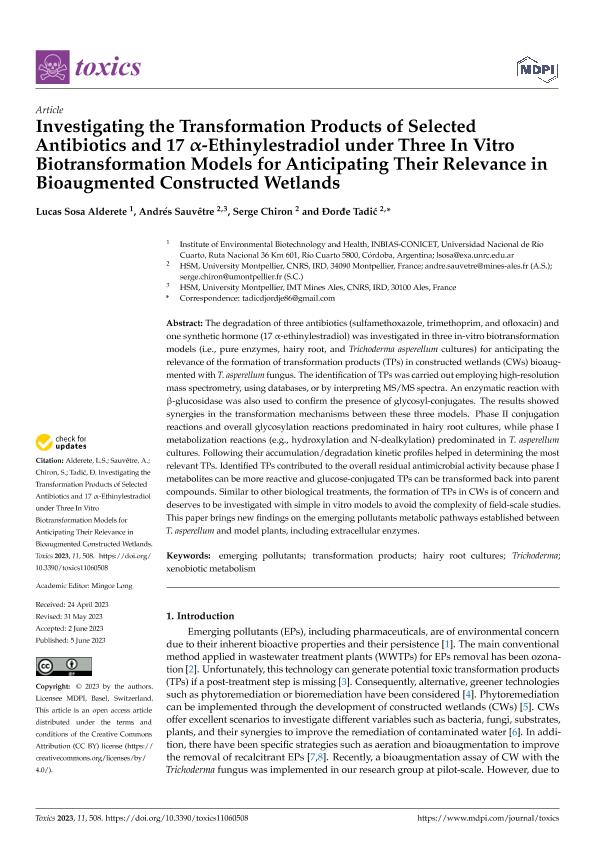Mostrar el registro sencillo del ítem
dc.contributor.author
Sosa Alderete, Lucas Gastón

dc.contributor.author
Sauvêtre, Andrés
dc.contributor.author
Chiron, Serge
dc.contributor.author
Tadic´, Ðorde
dc.date.available
2024-03-12T10:41:29Z
dc.date.issued
2023-06
dc.identifier.citation
Sosa Alderete, Lucas Gastón; Sauvêtre, Andrés; Chiron, Serge; Tadic´, Ðorde; Investigating the Transformation Products of Selected Antibiotics and 17 α-Ethinylestradiol under Three In Vitro Biotransformation Models for Anticipating Their Relevance in Bioaugmented Constructed Wetlands; Multidisciplinary Digital Publishing Institute; Toxics; 11; 6; 6-2023; 1-16
dc.identifier.issn
2305-6304
dc.identifier.uri
http://hdl.handle.net/11336/230116
dc.description.abstract
The degradation of three antibiotics (sulfamethoxazole, trimethoprim, and ofloxacin) and one synthetic hormone (17 α-ethinylestradiol) was investigated in three in-vitro biotransformation models (i.e., pure enzymes, hairy root, and Trichoderma asperellum cultures) for anticipating the relevance of the formation of transformation products (TPs) in constructed wetlands (CWs) bioaugmented with T. asperellum fungus. The identification of TPs was carried out employing high-resolution mass spectrometry, using databases, or by interpreting MS/MS spectra. An enzymatic reaction with β-glucosidase was also used to confirm the presence of glycosyl-conjugates. The results showed synergies in the transformation mechanisms between these three models. Phase II conjugation reactions and overall glycosylation reactions predominated in hairy root cultures, while phase I metabolization reactions (e.g., hydroxylation and N-dealkylation) predominated in T. asperellum cultures. Following their accumulation/degradation kinetic profiles helped in determining the most relevant TPs. Identified TPs contributed to the overall residual antimicrobial activity because phase I metabolites can be more reactive and glucose-conjugated TPs can be transformed back into parent compounds. Similar to other biological treatments, the formation of TPs in CWs is of concern and deserves to be investigated with simple in vitro models to avoid the complexity of field-scale studies. This paper brings new findings on the emerging pollutants metabolic pathways established between T. asperellum and model plants, including extracellular enzymes.
dc.format
application/pdf
dc.language.iso
eng
dc.publisher
Multidisciplinary Digital Publishing Institute
dc.rights
info:eu-repo/semantics/openAccess
dc.rights.uri
https://creativecommons.org/licenses/by/2.5/ar/
dc.subject
EMERGING POLLUTANTS
dc.subject
HAIRY ROOT CULTURES
dc.subject
TRANSFORMATION PRODUCTS
dc.subject
TRICHODERMA
dc.subject
XENOBIOTIC METABOLISM
dc.subject.classification
Otras Biotecnología del Medio Ambiente

dc.subject.classification
Biotecnología del Medio Ambiente

dc.subject.classification
INGENIERÍAS Y TECNOLOGÍAS

dc.title
Investigating the Transformation Products of Selected Antibiotics and 17 α-Ethinylestradiol under Three In Vitro Biotransformation Models for Anticipating Their Relevance in Bioaugmented Constructed Wetlands
dc.type
info:eu-repo/semantics/article
dc.type
info:ar-repo/semantics/artículo
dc.type
info:eu-repo/semantics/publishedVersion
dc.date.updated
2024-03-08T14:28:56Z
dc.journal.volume
11
dc.journal.number
6
dc.journal.pagination
1-16
dc.journal.pais
Suiza

dc.description.fil
Fil: Sosa Alderete, Lucas Gastón. Universidad Nacional de Río Cuarto. Facultad de Ciencias Exactas Fisicoquímicas y Naturales. Instituto de Biotecnología Ambiental y Salud - Consejo Nacional de Investigaciones Científicas y Técnicas. Centro Científico Tecnológico Conicet - Córdoba. Instituto de Biotecnología Ambiental y Salud; Argentina
dc.description.fil
Fil: Sauvêtre, Andrés. Université Montpellier II; Francia
dc.description.fil
Fil: Chiron, Serge. No especifíca;
dc.description.fil
Fil: Tadic´, Ðorde. No especifíca;
dc.journal.title
Toxics
dc.relation.alternativeid
info:eu-repo/semantics/altIdentifier/doi/http://dx.doi.org/10.3390/toxics11060508
Archivos asociados
